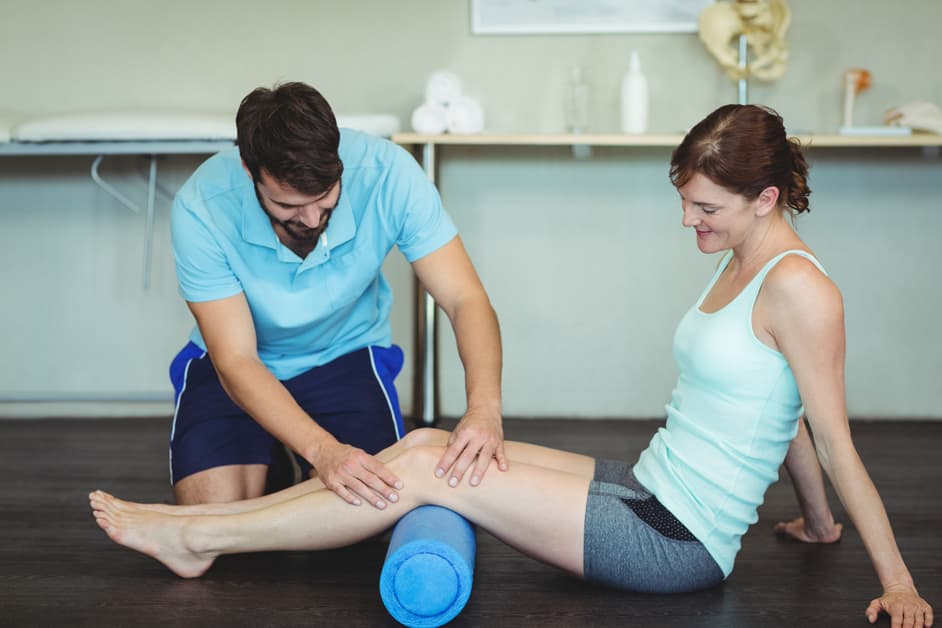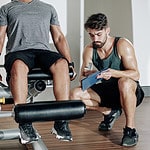Introduction
Foam rolling – a great way to upgrade your knee flexibility! It boosts blood flow, cuts down on stiffness, and even helps you dodge injury. In this article, you’ll get the lowdown on foam rolling and the advantages it brings to knee flexibility and mobility.
Benefits of Foam Rolling
Foam rolling has become a huge trend! It’s like a deep tissue massage, but with a specialized foam roller. Benefits include releasing muscle tightness, increasing flexibility, reducing stress, and faster recovery time from exercise. Plus, it can improve range of motion, joint functions, and posture.
To use the roller, roll over each muscle group for about 30 seconds. Even though it may feel uncomfortable at first, it shouldn’t be painful. Make sure to use proper technique – no unnecessary injuries or strain on muscles and joints! Vary the pressure depending on the area and your preference.
In conclusion, foam rolling is a great way to stay healthy and recover from workouts. But always talk to your doctor before starting, as some conditions may benefit more from other types of massage or physical therapies.
Preparation
Prep your body for foam rolling, to get the most from it when stretching your knees. Start with light physical activity like jogging, biking, or jumping jacks. This will help get blood flowing to the targeted areas and make foam rolling more successful.
Dynamic stretches pair well with foam rolling. Dynamic stretches involve moving through the full range of motion, which lubricates joints, reduces stiffness and increases knee flexibility and mobility.
Choosing the Right Foam Roller
Choosing a foam roller is an important part of exercising safely. They come in various shapes and sizes, so it’s hard to decide which one is best for you. Generally, smaller (half-round) ones are for shallow muscles and larger (cylinder) for deeper ones. As you get better at training, you may want to use a firmer foam roller with more resistance.
Before buying, assess your fitness level, any injuries or illnesses. If you have any serious medical conditions, talk to your doctor. A physical therapist or personal trainer can help you find the right product and learn safe form.
Consider both the length and firmness of the foam roller. 6-inch cylinders are recommended for knee flexibility exercises. Think about how often you’ll use it. Higher quality products may cost more upfront but last longer. Get a reputable brand with an instruction manual for correct usage and cleaning practices.
Finding a Comfortable Position
When using a foam roller for your knees, find a comfy position. Start by leaning against a wall or sitting in a chair. Leaning against an exercise ball may provide more comfort. Your body type determines the distance between your feet and upper body. Try different distances until you find the one that works best. Keep your arms slightly lower than your chest to gain stability during the exercise.
Foam Rolling Techniques
Foam Rolling is a self-myofascial release technique. It can help with knee flexibility, mobility, and reduce inflammation in the knee joint. It’s also a great way to recover from workouts, and prevent injuries.
We’ll talk about the best foam rolling techniques to improve knee flexibility and mobility:
Rolling the Quads
Foam roll your quads for an easy and effective way to break up knots and tightness. Here’s how:
- Lie on your back with feet flat and a foam roller under one leg.
- Use both hands to hold the roller and roll up and down the front of thigh. Focus on areas that are tense or sensitive.
- Create circles around delicate spots with shorter strokes.
- Do stretches before and after rolling to release tension in other muscles.
- Finally, do 10 even circles in each sore area before moving onto other parts of the body like the calves, hips, or glutes.
Rolling the IT Band
Rolling the IT Band can boost knee flexibility, reduce pain, and soothe inflammation. It’s a thick band of tissue that runs from the hip to the lower knee. Normally it connects and stabilizes muscles, but tightness in the joint can cause discomfort.
Foam rolling can help. It improves blood flow and breaks up tight fascia. Here’s how to do it:
- Lie on your side with legs straight. Prop up your upper body with one arm. Place one end of the roller above your knee joint. Roll slowly up toward your hip, rotating slightly as you go. Put some pressure on top so you feel relief.
- Keep rolling down until you reach where your IT band connects with the glutes. Rotate outward while still going downward, until you reach mid-thigh level. Hold each spot for 10-15 seconds, then repeat if desired. Reset at point 1, and repeat if necessary, working slowly down toward mid-thigh until you’re done.
Rolling the Hamstrings
Roll the hamstrings to boost knee flexion and improve leg mobility. Kneel on the ground with a foam roller in front of you. Place your left leg on the roller and extend your right leg back with a slight bend at the knee.
Cross your left ankle over your right foot. Lean onto your hands and roll up & down the length of your hamstring, from the bottom of your hip to just above your knee. Do this five to seven times per each direction. Pause when you find a sore spot, massage it for 8-10 secs then keep rolling until the tension releases.
Repeat the process on both legs, two or three sets in total. Adjust if needed depending on the sensitivity of each leg. Consider adding dynamic stretching or contract-relax techniques in between sets for a deeper release of tension in the muscles around the knees.
Post-Rolling Stretches
Foam rolling has lots of perks! For example, it can help with knee flexibility and mobility. After rolling, do post-rolling stretches to increase the knee joint’s moveability.
This article describes how to use a foam roller to enhance knee flexibility and mobility, plus what post-rolling stretches to do:
Quadriceps Stretch
Stretch your quadriceps muscles for improved flexibility. Begin by rolling out your thighs for 1 minute. This will prepare them for stretching and help reach deeper stretches.
Lie down on your stomach and place the foam roller beneath you. Start at mid-thigh, just below your hip bone. Roll down until you reach the crease near your knee. Place both hands flat on the ground and raise one leg behind you, keeping it close to a 90 degree angle. Stretch gently and hold for 20-30 seconds. Do this 3 times in each spot until you reach just above or below your knee. Repeat on the other side. Get up slowly when finished.
Hamstring Stretch
To make your hamstrings more flexible and mobile, use a foam roller. This stretch is great for your knees.
- Get comfortable on the foam roller. Sit with legs out in front. Put one hand under the ankle, and other on the side of the hip. Lean back. Keep your knee straight and toes up. Enjoy a mild, soothing stretch in the hamstrings.
- To increase the stretch, use arms to pull deeper into the foam roller. Hold for 30-45 seconds.
- Return to seated, then repeat 1-2 times for each leg.
Calf Stretch
Find tight spots or tension when using a foam roller on your calf muscles. Roll the foam roller back and forth and rotate your ankle. This can help reduce knots in the tissue. Spend 60 seconds on this.
Now move to a half-kneeling position. Place one foot on the floor and one knee on top of the foam roller. Keep your knee above your toes. Shift more weight onto the top leg for an increased range of motion. Hold this stretch for up to three minutes. Repeat this on both legs.
Conclusion
Foam rolling is fab for bettering knee flexibil’ and mobility. The pressure from the roller helps ease tension in the muscles and tendons surrounding the joint. It can also boost knee strength, coordination, and balance.
This article reviews the different ways of using a foam roller to improve knee flexibility and mobility:
Tips for Getting the Most out of Foam Rolling
Foam rolling can be a great way to boost knee flexibility and mobility. However, it’s essential to use the right techniques. Here are some tips:
- Start Slow: Roll out each leg separately, using moderate pressure and slow, controlled movements. This helps the muscles get used to the roller and prevents shocks or soreness.
- Focus on Problem Areas: Spend extra time on spots causing tightness or pain. Just use enough pressure to feel a good stretch in the area.
- Mix It Up: Don’t stick to one routine. Change up the motions and time spent on each area to reach different muscles.
- Stay Hydrated: Drink lots of water before, during, and after rolling. This helps muscles recover quickly and reduces soreness.
Frequently Asked Questions
Q1: What is a foam roller?
A1: A foam roller is a cylindrically shaped piece of foam that is used to help with self-massage and myofascial release. It is used to apply pressure to tight muscles and help them relax and release tension.
Q2: How should I use a foam roller to improve knee flexibility and mobility?
A2: To improve knee flexibility and mobility, begin by positioning the foam roller under your knee. Gently roll your knee along the top of the foam roller in a slow and controlled manner for 1 to 2 minutes. You can also try moving the foam roller towards and away from the body and side to side to target different areas of the knee.
Q3: How often should I use a foam roller?
A3: For best results, use the foam roller at least once a day. You may also want to use it after workouts or activities that place a lot of strain on your knees.





